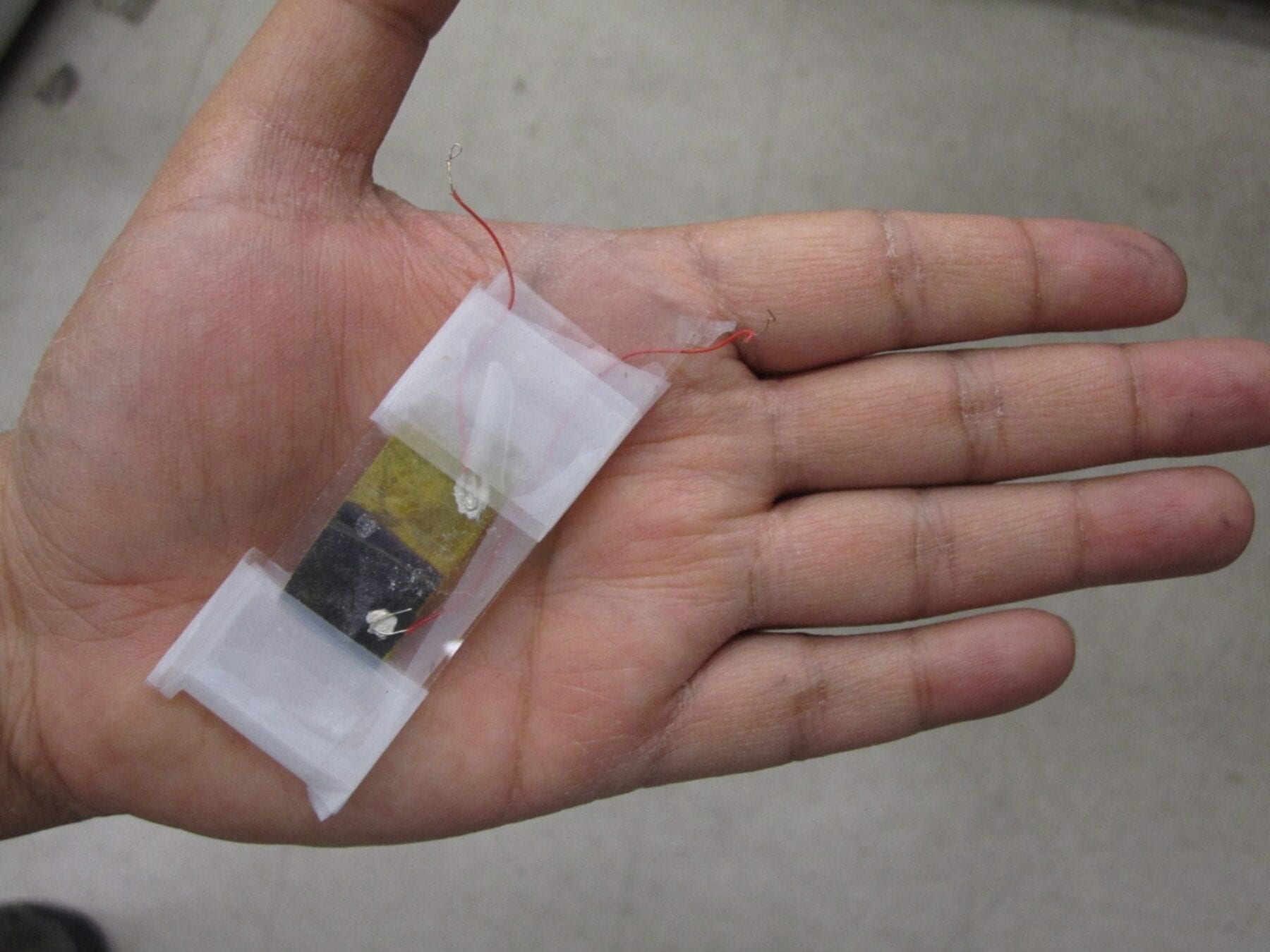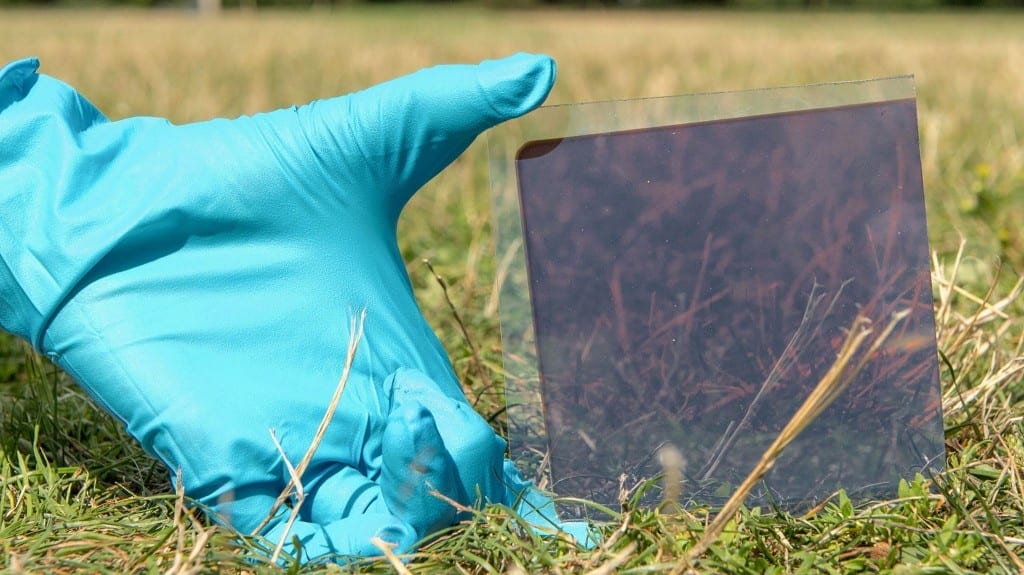
University of Utah metallurgists used an old microwave oven to produce a nanocrystal semiconductor rapidly using cheap, abundant and less toxic metals than other semiconductors.
They hope it will be used for more efficient photovoltaic solar cells and LED lights, biological sensors and systems to convert waste heat to electricity.
Using microwaves “is a fast way to make these particles that have a broad range of applications,” says Michael Free, a professor of metallurgical engineering. “We hope in the next five years there will be some commercial products from this, and we are continuing to pursue applications and improvements. It’s a good market, but we don’t know exactly where the market will go.”
Free and the study’s lead author, Prashant Sarswat, a research associate in metallurgical engineering, are publishing their study of the microwaved photovoltaic semiconductor – known as CZTS for copper, zinc, tin and sulfur – in the June 1 issue of the Journal of Crystal Growth.
In the study, they determined the optimum time required to produce the most uniform crystals of the CZTS semiconductor – 18 minutes in the microwave oven – and confirmed the material indeed was CZTS by using a variety of tests, such as X-ray crystallography, electron microscopy, atomic force microscopy and ultraviolet spectroscopy. They also built a small photovoltaic solar cell to confirm that the material works and demonstrate that smaller nanocrystals display “quantum confinement,” a property that makes them versatile for different uses.
“It’s not an easy material to make,” Sarswat says. “There are a lot of unwanted compounds that can form if it is not made properly.”
Sarswat says that compared with photovoltaic semiconductors that use highly toxic cadmium and arsenic, ingredients for CZTS photovoltaic material “are more environmentally friendly.”
Free adds: “The materials used for this are much lower cost and much more available than alternatives,” such as indium and gallium often used in semiconductors.
Making an Old Material More Quickly
Swiss researchers first invented CZTS in 1967 using another method. Other researchers discovered in 1998 that it could serve as a photovoltaic material. But until recently, “people haven’t explored this material very much,” Sarswat says. CZTS belongs to a family of materials named quaternary chalcogenides.
Without knowing it at first, Free and Sarswat have been in a race to develop the microwave method of making CZTS with a group of researchers at Oregon State University. Sarswat synthesized the material using microwaves in 2011. Free and Sarswat filed an invention disclosure on their method in January 2012, but the other group beat them into print with a study published in August 2012.
The method developed by Sarswat and Free has some unique features, including different “precursor” chemicals (acetate salts instead of chloride salts) used to start the process of making CZTS and a different solvent (oleylamine instead of ethylene glycol.)
Sarswat says many organic compounds are synthesized with microwaves, and Free notes microwaves sometimes are used in metallurgy to extract metal from ore for analysis. They say using microwaves to process materials is fast and often suppresses unwanted chemical “side reactions,” resulting in higher yields of the desired materials.
CZTS previously was made using various methods, but many took multiple steps and four to five hours to make a thin film of the material, known technically as a “p-type photovoltaic absorber,” which is the active layer in a solar cell to convert sunlight to electricity.
A more recent method known as “colloidal synthesis” – preparing the crystals as a suspension or “colloid” in a liquid by heating the ingredients in a large flask – reduced preparation time to 45 to 90 minutes.
Sarswat decided to try microwave production of CZTS when the University of Utah’s Department of Metallurgical Engineering decided to get a new microwave oven for the kitchen where students heat up their lunches and make coffee.
“Our department secretary had a microwave to throw away,” so Sarswat says he took it to replace one that had recently burned up during other lab experiments.
“The bottom line is you can use just a simple microwave oven to make the CZTS semiconductor,” Free says, adding: “Don’t do it at home. You have to be cautious when using these kinds of materials in a microwave.”
The Latest Bing News on:
Solar Cell Material
- Transparent Solar Panels: What Do They Cost, And Are There Any Disadvantages?on May 12, 2024 at 9:45 am
As a brilliant twist on a modern cost- and environmentally-conscious solution, transparent solar panels can be a game changer. Some questions may linger in the back of your mind, though, and we're ...
- Rooftop solar subsidy scheme a billion dollar opportunity for Tata Poweron May 12, 2024 at 6:57 am
Tata Power will be relying on its network of over 500 channel partners across 450 cities for the sale of its rooftop solar units ...
- UCSB Pioneers a Low-Energy Process for High-Performance Solar Cellson May 10, 2024 at 10:43 am
By Harrison Tasoff, UCSB Finding reliable, eco-friendly power sources is crucial as our world grapples with increasing energy needs and the urgent call to combat climate change. Solar energy offers ...
- Another solar tariff fight looms on Capitol Hillon May 10, 2024 at 3:53 am
Democrats, the solar industry and President Joe Biden are facing renewed tensions over imports from Asian countries.
- Harnessing Sunlight Like Never Before: Hemispherical Solar Cells Unleash Unmatched Absorptionon May 9, 2024 at 4:17 am
New research suggests redesigning organic solar cells with a hemispherical shell structure to provide broader angular coverage, which is particularly beneficial for devices that need adaptable light ...
- New doping strategy increases lead-free perovskite solar cell efficiencyon May 9, 2024 at 12:00 am
An international research group has developed a solar cell based on a lead-free perovskite material known as Cs2AgBiBr6. The cell's absorber was doped with trans-polyacetylene, which reportedly helped ...
- Solar Energy Newson May 8, 2024 at 5:00 pm
New High-Performance Solar Cell Material Mar. 13, 2024 — A new study reports the discovery of an entirely new stable, earth-abundant, high-performance material for solar absorbers -- the central ...
- DGIST identifies what causes electron-hole separation in thin-film solar cells to increase solar cell efficiencyon May 8, 2024 at 6:38 am
A joint research team between DGIST, Ewha Womans University, Incheon National University, and Sang-hoon Nam at MIT used atomic force microscopy to identify what causes electron-hole separation due to ...
- Low-energy process for high-performance solar cellson May 7, 2024 at 3:50 pm
Finding reliable, eco-friendly power sources is crucial as our world grapples with increasing energy needs and the urgent call to combat climate change. Solar energy offers one solution, with ...
- Researchers pioneer a low-energy process for high-performance solar cellson May 5, 2024 at 5:00 pm
Solar energy offers one solution, with scientists devising ever more efficient materials for capturing sunlight. Perovskite solar cells have emerged as a promising alternative to conventional, silicon ...
The Latest Google Headlines on:
Solar Cell Material
[google_news title=”” keyword=”Solar Cell Material” num_posts=”10″ blurb_length=”0″ show_thumb=”left”]
The Latest Bing News on:
CZTS semiconductor
- 8 Best Semiconductor Stocks Of May 2024on May 10, 2024 at 10:57 am
Commissions do not affect our editors' opinions or evaluations. The semiconductor sector is back, and it’s hotter than ever—at least as measured by the VanEck Semiconductor ETF (SMH), the ...
- Best Semiconductor Stockson May 9, 2024 at 12:59 pm
Invest in the best semiconductor stocks with Interactive Brokers today. Information technology is at the forefront of digital transformation. Computers, smartphones and smart TVs have become ...
- ON Semiconductor Corp ONon May 6, 2024 at 4:59 pm
We sell different types of products and services to both investment professionals and individual investors. These products and services are usually sold through license agreements or subscriptions ...
- Arizona is poised for further momentum after TSMC, Intel and other semiconductor victorieson May 5, 2024 at 11:00 pm
Arizona, over the past three years, has scored some huge victories in luring major semiconductor investments to the state, including a major Intel Corp. expansion in Chandler and the construction ...
- Best semiconductor ETFs of May 2024on May 1, 2024 at 5:00 pm
Please view our full advertiser disclosure policy. A straightforward and highly popular semiconductor ETF pick is SMH, which tracks the MVIS US Listed Semiconductor 25 Index. This index provides ...
- 4 Undervalued Semiconductor Stockson April 17, 2024 at 5:00 pm
While stocks have soared for the semiconductor companies at the heart of the artificial intelligence boom, there’s more to this industry than powering chatbots. Historic demand continues to rise ...
- 7 Best Semiconductor ETFs to Buy in 2024on April 16, 2024 at 7:45 am
In his 2022 book, "Chip War: The Fight for the World's Most Critical Technology," author Chris Miller highlighted a crucial vulnerability in the global semiconductor supply chain, with significant ...
- Samsung gets $6.4 billion to build massive semiconductor plants in central Texason April 15, 2024 at 10:01 am
The Biden administration is giving Samsung $6.4 billion to help build massive new semiconductor chip plants in central Texas, the latest in a series of investments that the government hopes will ...
- 7 Semiconductor Stocks to Turn $100,000 Into $1 Million: April 2024on April 13, 2024 at 2:59 am
Semiconductor stocks are a buy as the Nasdaq continues to make higher highs. These companies have been benefiting from the growing demand for electronic devices and the increased adoption of ...
The Latest Google Headlines on:
CZTS semiconductor
[google_news title=”” keyword=”CZTS semiconductor” num_posts=”10″ blurb_length=”0″ show_thumb=”left”]











